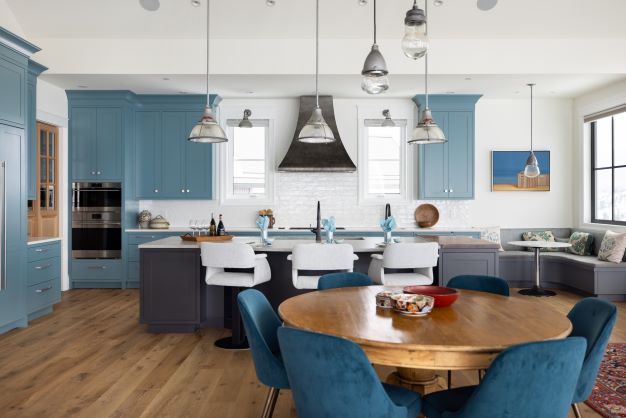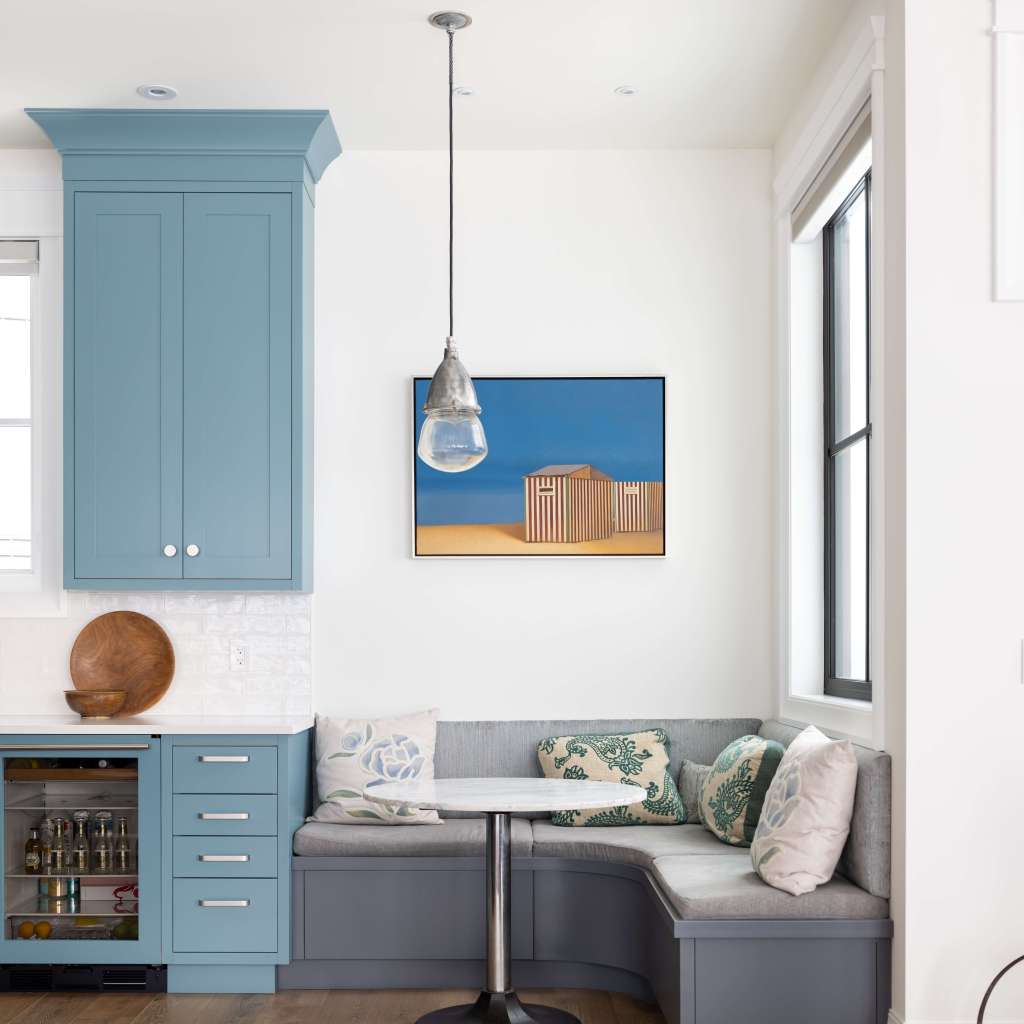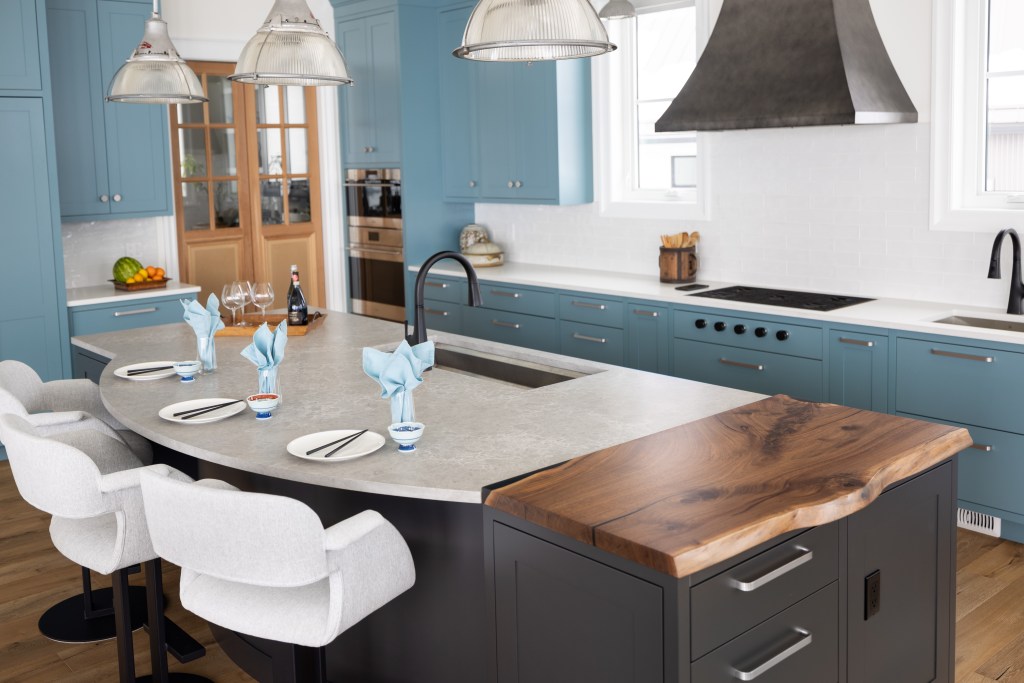Many years ago I purchased an acreage where I took up gardening.
I must admit I became a bit obsessed and by the end of my 5 years on the “farm” I had a 200′ by 200′ vegetable garden, a small orchard, a berry garden, a herb garden and multiple flower gardens.
With an abundance of produce being produced from the acreage, I needed to figure out what to do with it all!
This is when I learned how to preserve my harvest through home canning.
And being a Kitchen Designer was a great asset for planning the storage of my canning equipment and bounty.
Now with so many people taking up the art of canning due to the global pandemic, knowing how to plan a Kitchen to accommodate this trend is an asset.
Read on to get inspired to help your canning clients design the Kitchen of their dreams.

Backyard garden harvest 
Produce at a Farmers Market
Farmers markets, farm gate sales, you-picks and backyard gardens are traditional sources for produce for home canning, but even the suburban or urban grocery store can provide ingredients.
Because of this, do not assume that only your “country” clients need storage for home canning.
After I moved from the farm to a downtown condo, I still practiced small batch canning and needed to store the equipment.
Supplies

Basic Canning Supplies 
Canning jars & rings 
Pressure Canner
Most home canners need to store the following:
- Water bath canner
- Set of canning utensils
- Funnel and ladle
- Assorted jars
- Metal lids & rings
- and sometimes a Pressure canner
Storage
The items most difficult to store on this list are the water bath and pressure canner.

They are larger than a standard stock pot and in most cases will not fit into a standard pots & pans drawer.
Consider planning storage for them in a deep two drawer bank, on a shelf in a full height base cabinet, in the bottom of a drawer/door cabinet on a rollout shelf or on a shelf in a pantry.
Canning utensils can easily be stored in an upper drawer fitted with an utensil divider while lids & rings work well in a shallow drawer or in a basket on a shelf.

Storage needs for glass canning jars will vary the most from client to client.
How many jars they have will depend on how much canning they do each season.
The type of canning done will also determine storage requirements.

Canned peach & pear products 
Canned tomato sauces 
Canned beets and cherries
Above is some of the canning I did last year and as you can see I use a variety of jar sizes.
Since I love to can chutney’s, salsas, fruit butters, preserves, sauces, pickles, jams as well as plain fruits, most of my jars are pint size or smaller.
The smaller jar size also works well for me because there are only two of us, and I gift a lot of my concoctions.
For larger families the larger quart sized jar would be a more popular size for home canned goods.

Multiple shelf heights for canning 
Solid wood shelves for canning 
Canned goods on rollout shelves
The most common way of storing home canned goods is on solid shelves. The thicker the better due to the weight of filled jars.
Since you should never stack jars because this can break the seal, plan the shelves to accommodate different jar heights.
Shallow shelves that house only one or two jars deep works well for canners that produce a wide variety of small batch items. It allows the cook to see what they have.
If your client does large batch canning of the same type of item, deeper shelves can work.
Another solution for storage is divided drawers or pullout shelves. Many times the contents are labeled on the lid so this would be a great solution.
Appliances

Pro range is ideal for canning 
Strong ventilation will help remove steam and heat 
Multiple burners on a pro range accommodates large sauce pots and water bath canners
For the serious home canner a pro-style range and strong vent hood are the perfect choice.
Multiple burners allow cases of produce to be transformed in marathon canning sessions!
A strong vent hood will remove steam and heat during the hot summer canning season.

Gas cooktops are great for canning 
A pot filler above the range adds function
A standard gas cooktop or 30″ gas range are also good choices for the home canner.
A gas or propane burner has the power to heat up the large water bath canner and allows the heat to be cut off within seconds.
Add in a pot filler and you have a great compact canning station.
Flat glass electric cooking surfaces would not be my first choice for canning and I do not recommend this type of appliance to my clients that would like to can in their new kitchen.
Even though I personally have canned on an electric glass top cooktop, I am always nervous that the glass could crack due to trapped high heat and a long heating period.
I do know though that traditional canning cannot be done on an induction cooktop because the cookware is not compatible.
To be safe always check appliance manufacturers specifications when specifying appliances for your client that home cans.
Counter Space

Space is needed for cases of produce & empty jars 
Produce needs to be readied for canning 
The Cooking Zone is where most jar filling will occur 
A space for jars to sit for 24 hours post canning is needed
There are four things to consider when determining countertop requirements for a functional canning session.
- Counterspace for the fresh produce and empty jars
- Counterspace for prepping the produce
- Counterspace for filling the canning jars
- Counterspace for letting the jars cool down
Kitchens that employ Food Flow Theory will provide adequate counterspace for canning.
The Prep Zone is perfect for prepping the produce and the Cooking Zone is where jars can be filled prior to going into the canner.
If the Serving Zone in the new Kitchen Design has a lot of counter space it can double as the area that jars can cool down.

A place to house boxes of produce 
A place to cool jars prior to canning
Depending on how much produce is being processed, the Kitchen table may need to be pressed into service for fresh produce and later for a spot to place jars to cool down.
To conclude, knowing how to can is an asset when it comes to designing a Kitchen for the Home Canner, but it is not a requirement.
Follow the same process you would when designing any Kitchen and do a thorough Needs Assessment with your client and bring practical solutions to accommodate their canning needs.
For a final inspiration check out what my ultimate walk-in pantry for home canning would look like.
Fingers crossed this space becomes a reality in my personal Kitchen renovation!
Have you ever designed a Kitchen for a Home Canner? I’d love to hear about it so please leave me a comment below.
Also, if you would like to receive the VESTA Blog in your inbox each week, subscribe here.
[hubspot portal=”9253671″ id=”40a54a75-0df5-4740-9983-80e00fb4adde” type=”form”]
Jan Rutgers has been designing kitchens and products for over 25 years and is a recipient of Kitchen & Bath Design News’ Top Innovators in 2020 for the Kitchen & Bath Industry. She has designed more than 1000 kitchens learning valuable skills with each one! Her experience in Kitchen Design, Millwork Manufacturing and Product Development has led her to create VESTABUL SCHOOL OF DESIGN where she educates and mentors people passionate about the Kitchen Design Industry.









Loved all your ideas.Such a worth while project in this day and age